– Duke Philip the Bold was the great patron of the Carthusian monastery at Champmol, near Dijon. He employed Claus Sluter, whose Well of Moses features innovative statues of prophets with portrait-like features and realistic costumes
– Flemish painters popularized the use of oil paints on wooden panels. By superimposing translucent glazes, they created richer colors than possible using tempera or fresco.
– A major art form in churches and private homes alike was the altarpiece with folding wings. Campin’s Merode Altarpiece is an early example painted in oil, in which the Annunciation take place in a Flemish home. Typical of Northern Ren painting, the everyday objects depicted often have symbolic significance.
– Van Eyck and Vander Weyden established portraiture as an important art form in 15th cen flanders. Van Eyck’s self portrait reveals the growing self-awareness of Renaissance artists
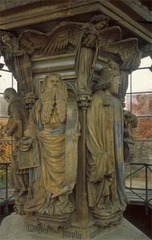
Well of Moses
Dijon, France
1395-1406
Limestone with traces of paint
– The well of Moses, a symbolic fountain of life made for the duke of Burgundy, originally supported a Crucifixion group. Sluter’s figures recall the jamb statues of French Gothic portals but are far more realistic
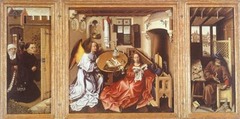
Merode Altarpiece
ca. 1425-1428
Oil on wood
– Campin set the Annunciation in a Flemish merchant’s home in which the everyday objects represented have symbolic significance. Oil paints permitted Campin to depict all the details with loving fidelity
– Private commission for a household
– In the right panel, Joseph has made a mousetrap, symbolic of the theological tradition that Christ is bait set in the trap of the world – center panel, the book, extinguished candle, and lilies represent the Virgin’s purity – in the left panel, the closed garden is symbolic of Mary’s purity and her virtues

Ghent Altarpiece (closed)
Ghent, Belgium
completed 1432
Oil on wood
– Monumental painted altarpieces were popular in the 15th century Flemish churches. Artists decorated both the interiors and exteriors of these hinged polyptychs, which often, as here, included donor portraits
– One of the largest altarpieces of the 15th century
– Flemish town represented
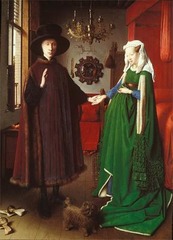
Giovanii Arnolfini and His Bride
1434
Oil on wood
– Van Eyck played a major role in popularizing oil painting and in establishing portraiture as an important art form. In this portrait of an Italian Financier and his wife, he also portrayed himself in the mirror
– Emerging capitalism led to an urban prosperity that fueled the growing bourgeois market for art objects – contributing to the growing interest of secular art
– Different objects symbolize different things
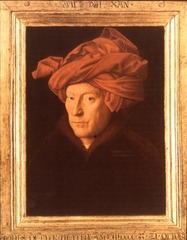
Man in a Red Turban
1433
Oil on wood
– Man in a red turban seems to be the first Western painted portrait in a thousand years in which the sitter looks directly at the viewer. The inscribed fram suggests it is a self portrait of Jan van Eyck
– Patrons wanted to memorialize themselves in their dynastic lines and to establish their identities, ranks, and stations with images far more concrete than heraldic coats of arms

Ghent Altarpiece (open)
Ghent, Belgium
completed 1432
Oil on wood
– In this painting of salvation from the Original Sin of Adam and Eve, God the Father presides in majesty. Van Eyck rendered every figure, garment, and object with fidelity to appearance
– Theme of salvation
– This kind of meticulous attention to recording the exact surface appearance of humans, animals, objects, and landscapes, already evident in the Merode Altarpiece, became the hallmark of Flemish panel painting in the 15th century

Portinari Altarpiece (open)
Florence, Italy
ca. 1476
Tempera and oil on wood
– This altarpiece is a rare instance of the awarding of a major commission in Florence to a Flemish painter. The Italians admired the incredibly realistic details an Hugo’s brilliant portrayal of human character
–

Last Supper, center panel of the Altarpiece of the Holy Sacrament
Louvain, Belgium
1464-1468
Oil on wood
– One of the earliest Northern European paintings to employ single-vanishing-point perspective, this last supper includes four servants in Flemish attire, probably portraits of the altarpieces patrons

Deposition, center panel of a triptych
Louvain, Belgium
ca. 1435
Oil on wood
– Deposition resembles a relief carving in which the biblical figures act out a drama of passionate sorrow as if on a shallow theatrical stage.
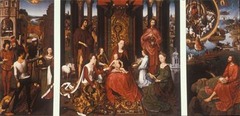
Virgin with Saints and Angels, center panel of the Saint John Altarpiece
Bruges, Belgium
1470
Oil on wood
– Memling specialized in images of the Madonna. His Saint John Altarpiece exudes an opulence that results from the sparkling and luminous colors and the realistic depiction of rich tapestries and brocades
– Patrons are shown on the side panels
– The Limbourg brothers expanded the illusionistic capabilities of manuscript illumination in the Book of Hours they produced. Their full-page calendar pictures alternately represent the nobility and the peasantry, always in naturalistic settings with realistically painted figures
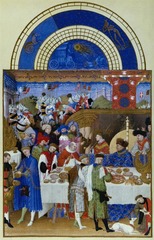
January, from Les Tres Riches Heures de Duc de Berry
1413-1416
Ink on vellum
– The pictures in Les Tres Riches Heures de Duc de Berry depict characteristic activities of each month and gives unusual prominence to genre subjects, reflecting the increasing integration of religious and secular art
– Translates to The Very Sumptuous Hours of the Duke of Berry – a book of hours was used for reciting prayers
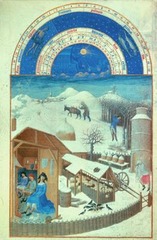
February, from Les Tres Riches Heures de Duc de Berry
1413-1416
Ink on vellum
– The pictures in Les Tres Riches Heures de Duc de Berry depict characteristic activities of each month and gives unusual prominence to genre subjects, reflecting the increasing integration of religious and secular art
– Translates to The Very Sumptuous Hours of the Duke of Berry – a book of hours was used for reciting prayers
– They expanded the illusionistic capabilities of manuscript painting with their care in rendering architectural details and convincing depictions of shadows cast by people and objects
– The major German innovation of the 15th century was the development of the printing press, which soon was used to produce books with woodcut illustrations. Woodcuts are relief prints in which the artist carves out the area around the printed lines, a method that requires the images to be conceptualized negatively
– German artists such as Martin Schongauer were also the earliest masters of engraving. This intaglio technique allows for a wider variety of linear effects because the artist incises the image directly onto a metal plate
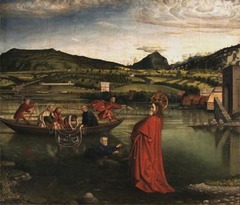
Miraculous Draught of Fish, from the Altarpiece of Saint Peter
Geneva, Switzerland
1444
Oil on wood
– Konrad Witz set this Gospel episode on Lake Geneva. The painting is one of the first 15th century works depicting a specific landscape and is noteworthy for the painter’s skill in rendering water effects
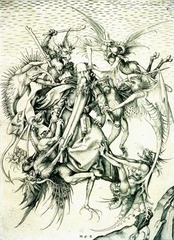
Saint Anthony Tormented by Demons
ca. 1480-1490
Engraving
– Martin Schongauer was the most skilled of the early masters of metal engraving. By using a burin to incise lines in a copper plate, he was able to create a marvelous variety of tonal values and textures
– As a result, Protestant churches were relatively bare, but art, especially prints, still played a role in Protestantism.
– The greatest printmaker of the Holy Roman Empire was Durer, who was also a painter. Durer was the first artist outside Italy to become an international celebraty. His work reanged from biblical subjects to botanical studies. Fall of Man reflects Durer’s studies of Vitruvian theory of human proportions and of classical statuary
– Other German artists, such as Hans Holbien was a renowned portraitist who became court painter in England. His French Ambassadors portrays two wordly humansts and includes a masterfully rendered anamorphic skull

Isenheim Altarpiece (closed)
Isenheim, Germany
ca, 1510-1515
Oil on wood
– Befitting its setting in a monastic hospital, this altarpiece includes painted panels depicting suffering and disease but also miraculous healing, hope, and salvation
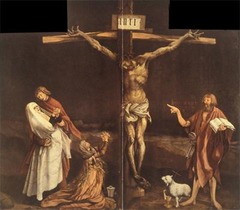
Center panel from Isenheim Altarpiece (closed)
Isenheim, Germany
ca, 1510-1515
Oil on wood
– Crucifixion in the center, reflects Catholic beliefs and incorporates several references to Catholic doctrines, such as the lamb (symbol of the son of God), whose wounds spurts blood into a chalice
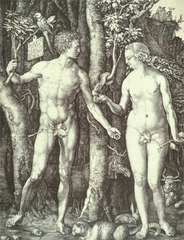
Fall of Man (Adam and Eve)
1504
Engraving
– Albrecht Durer was the first Northern European artist to become an international celebrity. Fall of Man, with two figures based on ancient statues, reflects his studies of the Vitruvian theory of human proportions.
– Name and date hanging from branch
– Represents the first distillation of his studies of the Vitruvian theory of human proportions, a theory based on arithmetic ratios

Knight, Death, and the Devil
1513
Engraving
– Durer’s Christian knight, armed with his faith, rides fearlessly through a meticulously rendered landscape, challenging both Death and the Devil. The engraving rivals the tonal range of painting

Four Apostles
1526
Oil on wood
– Durer’s support for Lutheranism surfaced in his portrait-like depictions of four saints o two painted panels. Peter, representative of the pope in Rome, plays a secondary role behind John the Evangelist
– Mark and Paul on the right panel
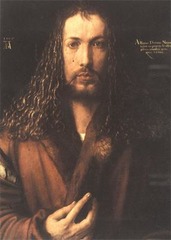
Self-Portrait
1500
Oil on panel
– Making direct eye contact with the viewer
– Made to look Jesus-like
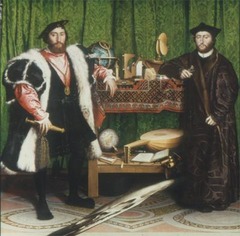
The French Ambassadors
1533
Oil and tempera on wood
– In this double portrait, Holdein depicted two humanists with a collection of objects reflective of their worldliness and learning, but he also included an anamorphic skull, a reminder of death
– Pieter Brugel’s repertory also included landscape painting. His hunters in the snow is one of a series of paintings depicting seasonal changes of the year and the activities associated with them, as in traditional Books of Hours
– Prominent female artists of the period include Caterina van Hemmessen, who painted the first known Northern European self-portrait of a woman, and Levina Teerlinc, who painted portraits for the English Court
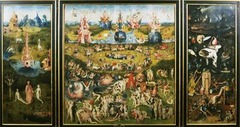
Garden of Earthly Delights
1505-1510
Oil on wood
– Bosch was the most imaginative and enigmatic painter of his era. In this triptych, which may commemorate a wedding, he created a fantasy world filled with nude men and women and bizarre creatures and objects
– Left panel- God presents Eve to Adam in a landscape, Garden of Eden
– Right panel- in contrast, bombards viewers with the horrors of Hell
– Center panel – nude people blithely cavort in a landscape dotted with bizarre creates and unidentifiable objects, many symbols for fertility suggest procreation, orgaistic overtones – possibly interpreted as a last judgment triptych
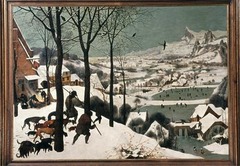
Hunters in the Snow
1565
Oil on wood
– One of a series of paintings illustrating annual seasonal changes, Bruegel draws the viewer diagonally deep into the landscape by his mastery of line, shape, and composition
– Actually depicting the type of winter they had in 1565
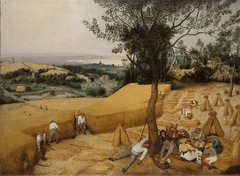
The Harvest
1565
Oil on wood
– Another painting of six depicting conditions and activity during different times of a year




